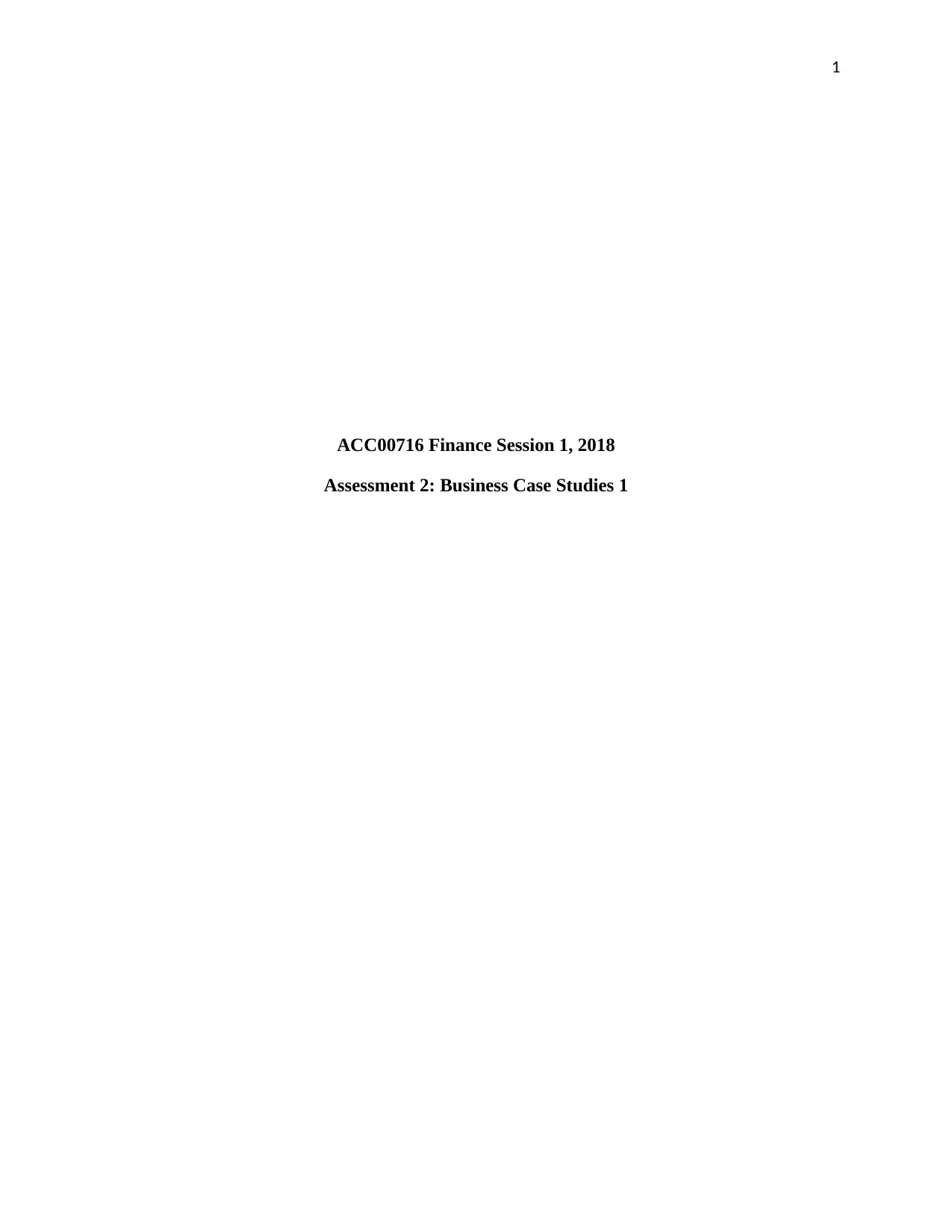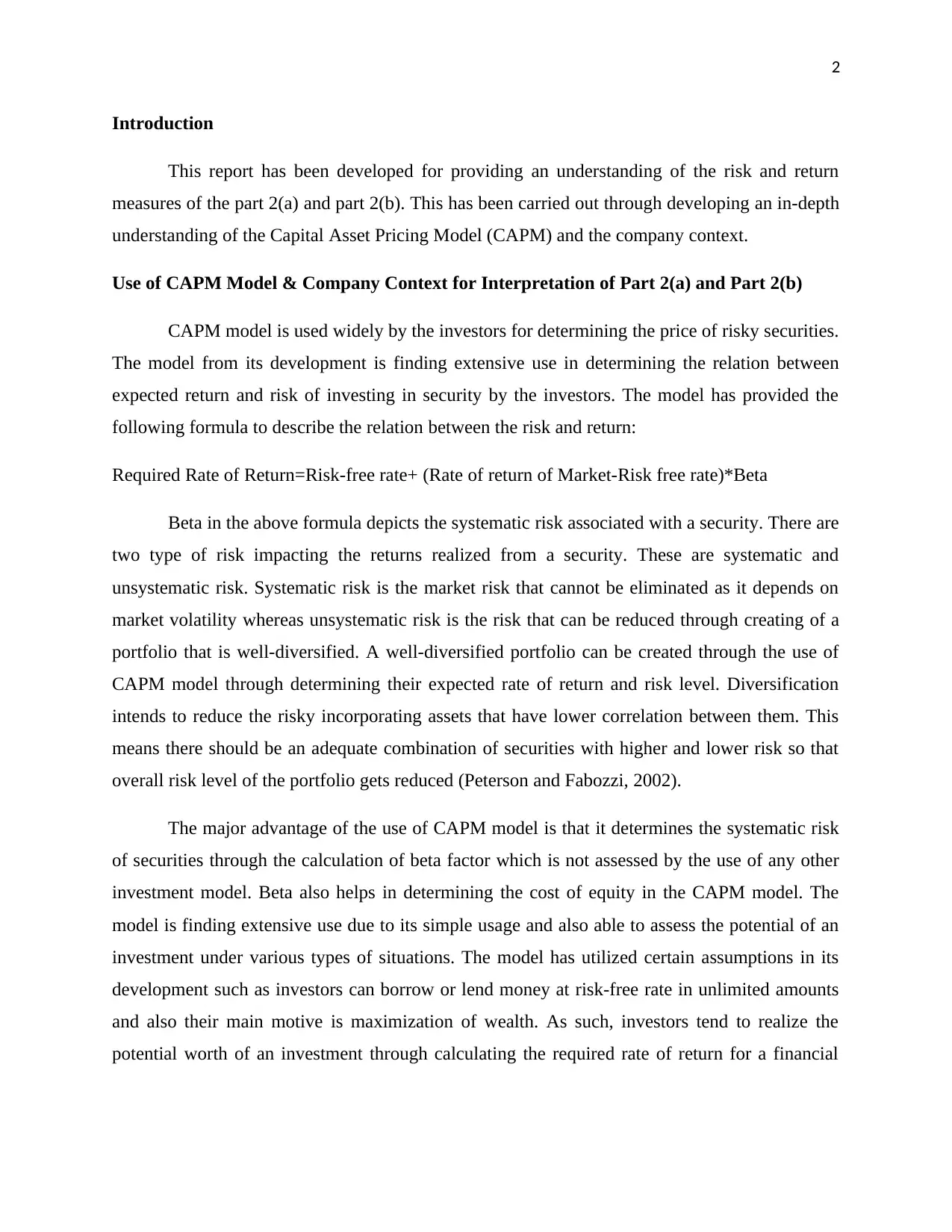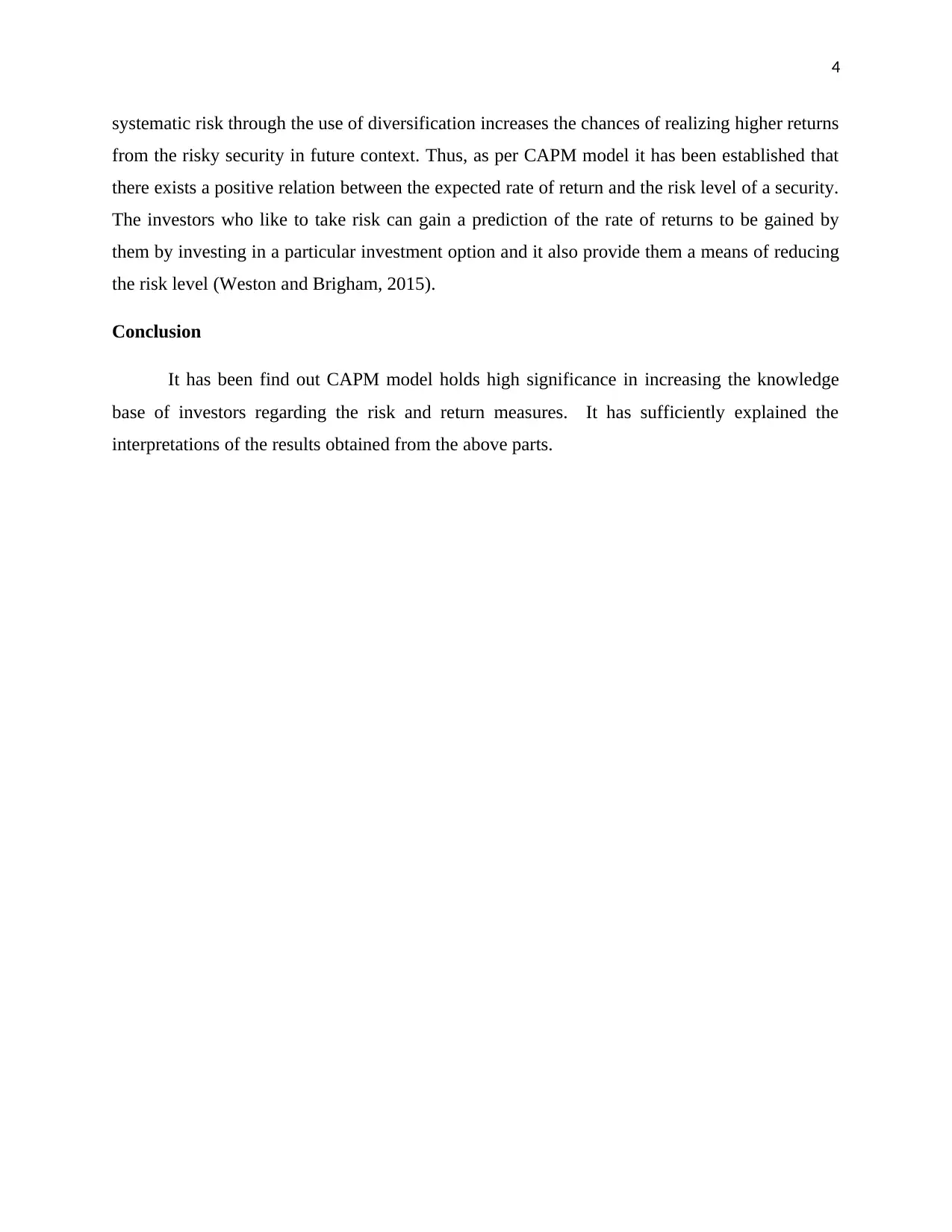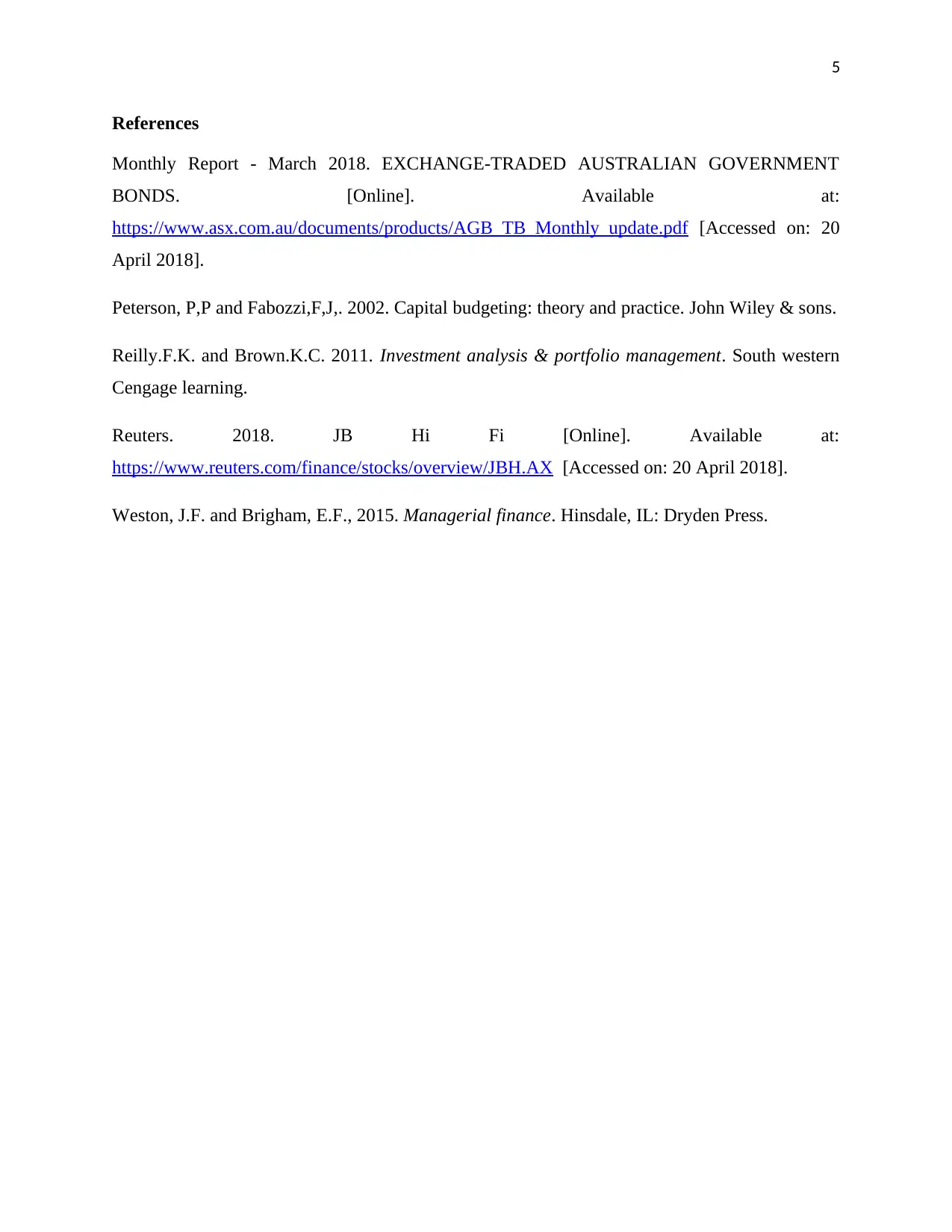Business Case Study: Risk and Return Analysis of JB Hi-Fi - ACC00716
VerifiedAdded on 2023/06/12
|5
|1235
|209
Case Study
AI Summary
This report provides an analysis of risk and return measures, focusing on JB Hi-Fi, using the Capital Asset Pricing Model (CAPM). It explains the CAPM model, its assumptions, and its application in determining the required rate of return for JB Hi-Fi. The analysis compares JB Hi-Fi's beta factor and expected return with a hypothetical company, highlighting the higher risk and potential return of investing in JB Hi-Fi stocks. The report also explores portfolio diversification as a strategy to manage risk, demonstrating how combining JB Hi-Fi stocks with a less risky security can reduce overall portfolio risk. The findings support the positive relationship between risk and expected return, offering insights for investors on risk management and return optimization. The analysis utilizes real market data, including Australian treasury bond rates and JB Hi-Fi's beta from Reuters, to provide a practical assessment of investment opportunities.

1
ACC00716 Finance Session 1, 2018
Assessment 2: Business Case Studies 1
ACC00716 Finance Session 1, 2018
Assessment 2: Business Case Studies 1
Paraphrase This Document
Need a fresh take? Get an instant paraphrase of this document with our AI Paraphraser

2
Introduction
This report has been developed for providing an understanding of the risk and return
measures of the part 2(a) and part 2(b). This has been carried out through developing an in-depth
understanding of the Capital Asset Pricing Model (CAPM) and the company context.
Use of CAPM Model & Company Context for Interpretation of Part 2(a) and Part 2(b)
CAPM model is used widely by the investors for determining the price of risky securities.
The model from its development is finding extensive use in determining the relation between
expected return and risk of investing in security by the investors. The model has provided the
following formula to describe the relation between the risk and return:
Required Rate of Return=Risk-free rate+ (Rate of return of Market-Risk free rate)*Beta
Beta in the above formula depicts the systematic risk associated with a security. There are
two type of risk impacting the returns realized from a security. These are systematic and
unsystematic risk. Systematic risk is the market risk that cannot be eliminated as it depends on
market volatility whereas unsystematic risk is the risk that can be reduced through creating of a
portfolio that is well-diversified. A well-diversified portfolio can be created through the use of
CAPM model through determining their expected rate of return and risk level. Diversification
intends to reduce the risky incorporating assets that have lower correlation between them. This
means there should be an adequate combination of securities with higher and lower risk so that
overall risk level of the portfolio gets reduced (Peterson and Fabozzi, 2002).
The major advantage of the use of CAPM model is that it determines the systematic risk
of securities through the calculation of beta factor which is not assessed by the use of any other
investment model. Beta also helps in determining the cost of equity in the CAPM model. The
model is finding extensive use due to its simple usage and also able to assess the potential of an
investment under various types of situations. The model has utilized certain assumptions in its
development such as investors can borrow or lend money at risk-free rate in unlimited amounts
and also their main motive is maximization of wealth. As such, investors tend to realize the
potential worth of an investment through calculating the required rate of return for a financial
Introduction
This report has been developed for providing an understanding of the risk and return
measures of the part 2(a) and part 2(b). This has been carried out through developing an in-depth
understanding of the Capital Asset Pricing Model (CAPM) and the company context.
Use of CAPM Model & Company Context for Interpretation of Part 2(a) and Part 2(b)
CAPM model is used widely by the investors for determining the price of risky securities.
The model from its development is finding extensive use in determining the relation between
expected return and risk of investing in security by the investors. The model has provided the
following formula to describe the relation between the risk and return:
Required Rate of Return=Risk-free rate+ (Rate of return of Market-Risk free rate)*Beta
Beta in the above formula depicts the systematic risk associated with a security. There are
two type of risk impacting the returns realized from a security. These are systematic and
unsystematic risk. Systematic risk is the market risk that cannot be eliminated as it depends on
market volatility whereas unsystematic risk is the risk that can be reduced through creating of a
portfolio that is well-diversified. A well-diversified portfolio can be created through the use of
CAPM model through determining their expected rate of return and risk level. Diversification
intends to reduce the risky incorporating assets that have lower correlation between them. This
means there should be an adequate combination of securities with higher and lower risk so that
overall risk level of the portfolio gets reduced (Peterson and Fabozzi, 2002).
The major advantage of the use of CAPM model is that it determines the systematic risk
of securities through the calculation of beta factor which is not assessed by the use of any other
investment model. Beta also helps in determining the cost of equity in the CAPM model. The
model is finding extensive use due to its simple usage and also able to assess the potential of an
investment under various types of situations. The model has utilized certain assumptions in its
development such as investors can borrow or lend money at risk-free rate in unlimited amounts
and also their main motive is maximization of wealth. As such, investors tend to realize the
potential worth of an investment through calculating the required rate of return for a financial

3
asset. These assumptions may not be applied in real world and therefore they can limit the
practical usefulness of the CAPM model (Reilly and Brown, 2011).
The Capital Asset Pricing Model has been used in calculating the required rate of return
of Jb Hi-Fi. As per the model, the expected rate of return for the company is mainly dependent
on the beta factors of the company. This si because risk-free rate and market premium is same
for all companies that is listed on a same index. As such, the relation between the expected return
and beta factor can be determined through calculating the expected return by taking beta of the
company from Reuters. The risk-free rate of return for the calculation of the expected return is
taken to be 2.60 (Monthly Report – March, 2018) provided by the 10 year Australian treasury
bonds. The market risk of Jb Hi-Fi and the hypothetical company that is assumed is 6.50% which
is given in the question. Thus, the risk-free rate and market risk premium for both Jb Hi-Fi and
the hypothetical company is 2.60 and 6.50.
Beta factor of the company assumed is given as -0.25and that of the company selected,
that is, Jb Hi-Fi is 0.45 (Reuters, 2018). This clearly indicates that beta factor of the company
selected is higher in comparison to that assumed company. Therefore, this means that stock of Jb
Hi-Fi have more chances of undergoing fluctuations in the prices as per the market conditions in
comparison to the company that has been assumed. There is higher level of risk for the investors
as they invest in sticks of Jb Hi-Fi. On the other hand, this also depicts an attractive opportunity
before the investors to realize higher returns through investing in Jb Hi-Fi stocks as they have
higher level of systematic risk. As per CAPM model, the higher level of systematic risk means
that there is high opportunity of realizing more returns from the investment in consideration. The
expected return to be realized from Jb Hi-Fi is 5.53% and from the company that is assumed is
0.98% by the use of formula of CAPM. This clearly indicates that Jb Hi-Fi is expected to provide
higher rate of return to the investors if they can manage the risk level properly.
The investors can manage the risk level through developing a well-diversified portfolio.
The portfolio developed with consists of 50% of stocks of the company Jb Hi-Fi and 50% of that
of the assumed company. This will lead to creation of a portfolio that has the combination of a
risky and a non-risky security. Therefore, the overall level of risk of the portfolio will be reduced
to a large extent. The same has also been obtained from the calculation in which the beta of
portfolio comes out to be 0.10 and the expected rate of return is 3.25%. The reduction in the
asset. These assumptions may not be applied in real world and therefore they can limit the
practical usefulness of the CAPM model (Reilly and Brown, 2011).
The Capital Asset Pricing Model has been used in calculating the required rate of return
of Jb Hi-Fi. As per the model, the expected rate of return for the company is mainly dependent
on the beta factors of the company. This si because risk-free rate and market premium is same
for all companies that is listed on a same index. As such, the relation between the expected return
and beta factor can be determined through calculating the expected return by taking beta of the
company from Reuters. The risk-free rate of return for the calculation of the expected return is
taken to be 2.60 (Monthly Report – March, 2018) provided by the 10 year Australian treasury
bonds. The market risk of Jb Hi-Fi and the hypothetical company that is assumed is 6.50% which
is given in the question. Thus, the risk-free rate and market risk premium for both Jb Hi-Fi and
the hypothetical company is 2.60 and 6.50.
Beta factor of the company assumed is given as -0.25and that of the company selected,
that is, Jb Hi-Fi is 0.45 (Reuters, 2018). This clearly indicates that beta factor of the company
selected is higher in comparison to that assumed company. Therefore, this means that stock of Jb
Hi-Fi have more chances of undergoing fluctuations in the prices as per the market conditions in
comparison to the company that has been assumed. There is higher level of risk for the investors
as they invest in sticks of Jb Hi-Fi. On the other hand, this also depicts an attractive opportunity
before the investors to realize higher returns through investing in Jb Hi-Fi stocks as they have
higher level of systematic risk. As per CAPM model, the higher level of systematic risk means
that there is high opportunity of realizing more returns from the investment in consideration. The
expected return to be realized from Jb Hi-Fi is 5.53% and from the company that is assumed is
0.98% by the use of formula of CAPM. This clearly indicates that Jb Hi-Fi is expected to provide
higher rate of return to the investors if they can manage the risk level properly.
The investors can manage the risk level through developing a well-diversified portfolio.
The portfolio developed with consists of 50% of stocks of the company Jb Hi-Fi and 50% of that
of the assumed company. This will lead to creation of a portfolio that has the combination of a
risky and a non-risky security. Therefore, the overall level of risk of the portfolio will be reduced
to a large extent. The same has also been obtained from the calculation in which the beta of
portfolio comes out to be 0.10 and the expected rate of return is 3.25%. The reduction in the
⊘ This is a preview!⊘
Do you want full access?
Subscribe today to unlock all pages.

Trusted by 1+ million students worldwide

4
systematic risk through the use of diversification increases the chances of realizing higher returns
from the risky security in future context. Thus, as per CAPM model it has been established that
there exists a positive relation between the expected rate of return and the risk level of a security.
The investors who like to take risk can gain a prediction of the rate of returns to be gained by
them by investing in a particular investment option and it also provide them a means of reducing
the risk level (Weston and Brigham, 2015).
Conclusion
It has been find out CAPM model holds high significance in increasing the knowledge
base of investors regarding the risk and return measures. It has sufficiently explained the
interpretations of the results obtained from the above parts.
systematic risk through the use of diversification increases the chances of realizing higher returns
from the risky security in future context. Thus, as per CAPM model it has been established that
there exists a positive relation between the expected rate of return and the risk level of a security.
The investors who like to take risk can gain a prediction of the rate of returns to be gained by
them by investing in a particular investment option and it also provide them a means of reducing
the risk level (Weston and Brigham, 2015).
Conclusion
It has been find out CAPM model holds high significance in increasing the knowledge
base of investors regarding the risk and return measures. It has sufficiently explained the
interpretations of the results obtained from the above parts.
Paraphrase This Document
Need a fresh take? Get an instant paraphrase of this document with our AI Paraphraser

5
References
Monthly Report - March 2018. EXCHANGE-TRADED AUSTRALIAN GOVERNMENT
BONDS. [Online]. Available at:
https://www.asx.com.au/documents/products/AGB_TB_Monthly_update.pdf [Accessed on: 20
April 2018].
Peterson, P,P and Fabozzi,F,J,. 2002. Capital budgeting: theory and practice. John Wiley & sons.
Reilly.F.K. and Brown.K.C. 2011. Investment analysis & portfolio management. South western
Cengage learning.
Reuters. 2018. JB Hi Fi [Online]. Available at:
https://www.reuters.com/finance/stocks/overview/JBH.AX [Accessed on: 20 April 2018].
Weston, J.F. and Brigham, E.F., 2015. Managerial finance. Hinsdale, IL: Dryden Press.
References
Monthly Report - March 2018. EXCHANGE-TRADED AUSTRALIAN GOVERNMENT
BONDS. [Online]. Available at:
https://www.asx.com.au/documents/products/AGB_TB_Monthly_update.pdf [Accessed on: 20
April 2018].
Peterson, P,P and Fabozzi,F,J,. 2002. Capital budgeting: theory and practice. John Wiley & sons.
Reilly.F.K. and Brown.K.C. 2011. Investment analysis & portfolio management. South western
Cengage learning.
Reuters. 2018. JB Hi Fi [Online]. Available at:
https://www.reuters.com/finance/stocks/overview/JBH.AX [Accessed on: 20 April 2018].
Weston, J.F. and Brigham, E.F., 2015. Managerial finance. Hinsdale, IL: Dryden Press.
1 out of 5
Related Documents
Your All-in-One AI-Powered Toolkit for Academic Success.
+13062052269
info@desklib.com
Available 24*7 on WhatsApp / Email
![[object Object]](/_next/static/media/star-bottom.7253800d.svg)
Unlock your academic potential
Copyright © 2020–2025 A2Z Services. All Rights Reserved. Developed and managed by ZUCOL.



